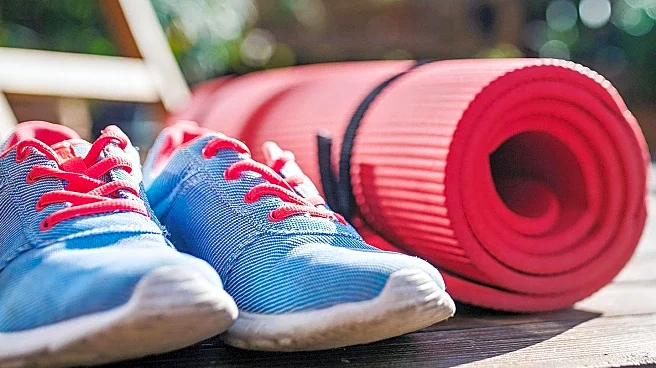What is the story about?
What's Happening?
Kate Rowe-Ham, a menopause fitness coach, has shifted her exercise routine from high-intensity interval training (HIIT) and spin classes to walking and weight training to manage her perimenopause symptoms. After experiencing anxiety, breathlessness, and joint pain, Rowe-Ham discovered that these symptoms were linked to perimenopause. She began weightlifting three to four times a week and reduced her HIIT classes, noticing immediate improvements in energy and anxiety levels. The addition of daily walking further alleviated her joint pain, as walking increases the circulation of synovial fluid, reducing inflammation. Rowe-Ham emphasizes the importance of adapting exercise routines to accommodate the changes in the body during perimenopause.
Why It's Important?
This shift in exercise strategy highlights the need for women experiencing perimenopause to adjust their fitness routines to better suit their changing bodies. Walking and strength training can help stabilize blood sugar levels, reduce hot flushes, and improve sleep quality by balancing hormones. These activities also promote muscle growth and bone density, which are crucial as estrogen levels decline. By adopting a routine that includes walking and weight training, women can mitigate the risk of diabetes, heart disease, and osteoporosis, while maintaining overall health and well-being during perimenopause.
What's Next?
Rowe-Ham suggests that women in their 40s aim to walk 30 to 40 minutes daily and engage in strength training sessions three times a week, focusing on different body areas. This balanced approach can help manage perimenopause symptoms effectively. As more women become aware of the benefits of adjusting their exercise routines, there may be increased interest in fitness programs tailored to perimenopause, potentially leading to new offerings in the fitness industry.
Beyond the Headlines
The approach advocated by Rowe-Ham underscores the importance of listening to one's body and adapting exercise routines to meet its needs. This perspective may encourage a broader cultural shift towards personalized fitness regimens that prioritize long-term health over short-term performance goals. As awareness grows, there could be a greater emphasis on holistic health practices that integrate physical activity with mental and emotional well-being.
AI Generated Content
Do you find this article useful?
















